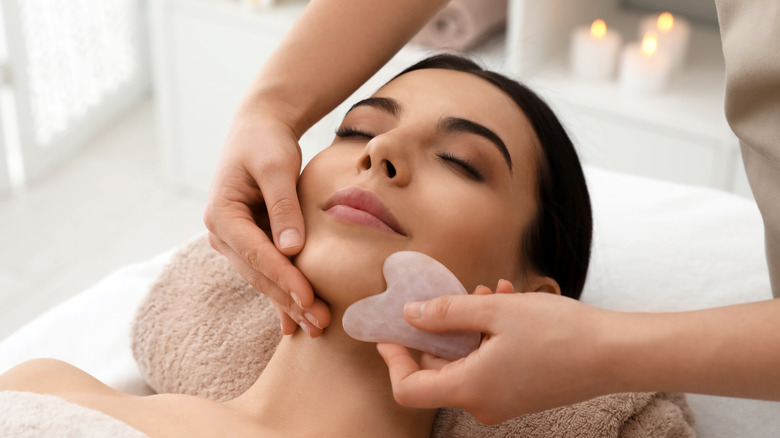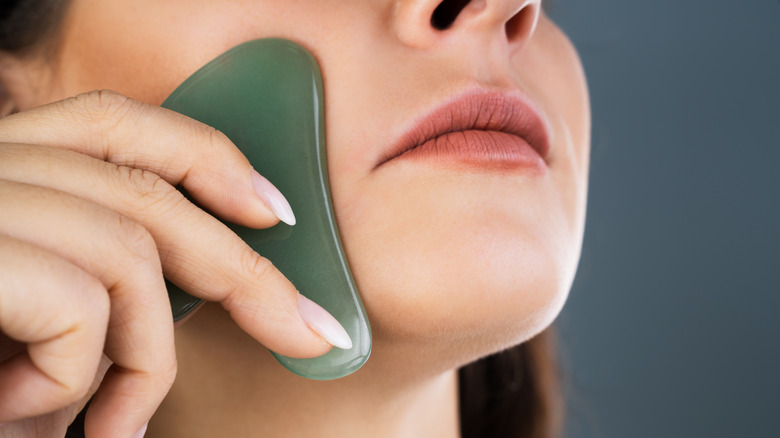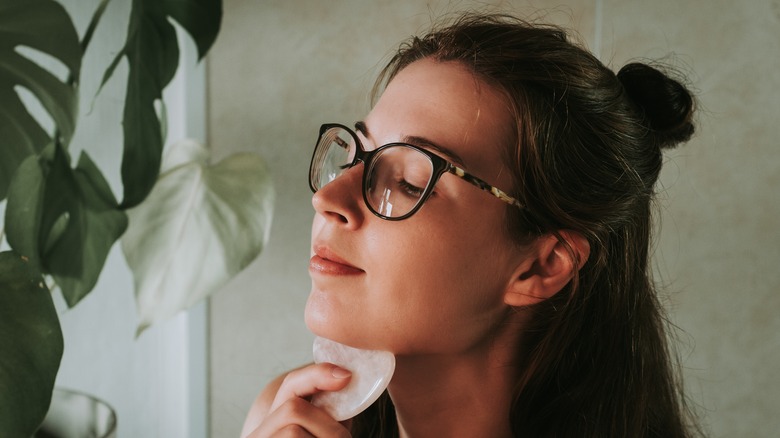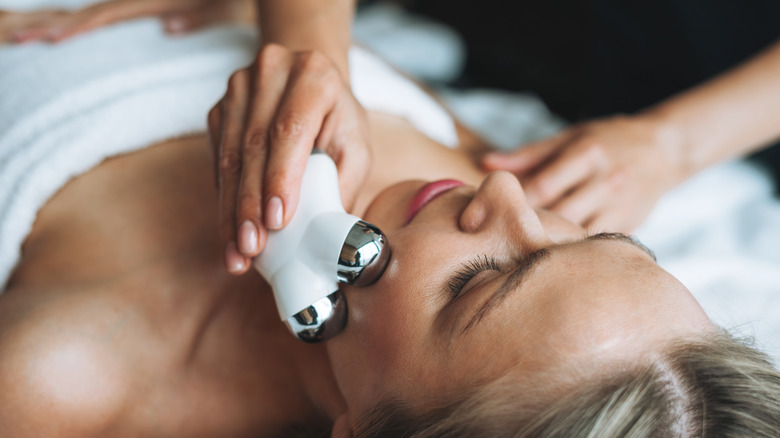Gua Sha Vs. Microcurrent Device: Which Is Better For Face Sculpting?
We may receive a commission on purchases made from links.
Beauty may be in the eye of the beholder, but it's pretty safe to say that having a snatched jawline has always been in vogue. That said, some of us have it easier than others in the bone structure department. "There are some people who have a face that's very sculpted, whether they're cheekbones or more highlighted. [Others] have a more cherubic face. Some people call it chipmunk cheeks," Dr. Andrew Jacono tells The New York Times. While there's nothing wrong with having rounder features, many seek to achieve a more angular, lifted look through the use of cosmetics or aesthetic interventions. From contouring makeup tutorials to buccal fat removal procedures, there are many ways for beauty enthusiasts to achieve the defined jawline and lifted cheeks of their dreams.
Still, you don't need to wear layers of makeup or go under the knife to get the coveted snatched look. In fact, you may have heard of two at-home solutions making a stir in the beauty world for their lifting and contouring effects: facial gua sha and microcurrent devices. But what can gua sha and microcurrent really do for your face? Ahead, we'll explain the difference between these two tools and help you choose which is best for you.
What is Gua Sha?
Gua sha tools are small, curved pieces of stone, metal, or synthetic material made to hug the contours of your jaw and cheeks for a facial massage. Although gua shas have recently surged in popularity, thanks in part to social media skinfluencers, the art of skin scraping is nothing new. In traditional Chinese medicine, gua sha therapy has been practiced for centuries, but it didn't always carry the beautifying reputation that it holds today. "Gua sha was originally used for two conditions: the abrupt, immediate, sudden collapse of the body from heatstroke, and seasonal diseases, like a cold virus," Dr. Ping Zhang tells Vogue.
So what are the benefits of facial gua sha? When used properly, gua sha tools may reduce puffiness, define the contours of your face, and improve circulation. "Using a jade gua sha tool at home essentially gives your face a mini workout — you are stimulating blood circulation, which increases the amount of oxygen and nutrients to the skin, which can improve skin health," Dr. Nyla Raja told HuffPost. Gua sha tools are available in a variety of materials, ranging from plastic to stainless steel, but many people prefer to use natural jade or rose quartz gua shas.
Gua sha is best for releasing facial tension
Gua sha works by increasing circulation on the surface of the skin, which can help to reduce facial swelling. In terms of its lifting effects, however, the jury is still out. One article published in the Journal of Cosmetic Dermatology found that facial massage tools like gua sha could have potential as anti-aging treatments, but more research is needed to fully identify their capabilities.
In general, acupuncturists say that less is more when using gua sha, as using too much pressure can harm the delicate tissues of the face. "Don't rub your gua sha tool back and forth, up and down, and in all different angles vigorously because that's going to just stretch and aggravate the skin. Keep things going in one smooth direction, and do it enough to get a little redness to form, but not so much that it hurts," licensed acupuncturist Tim Sobo tells the Cleveland Clinic. Although some people use gua sha on their face every day, many believe that two to three sessions per week can provide adequate results.
According to gua sha devotees, there are numerous benefits to using the facial tool. "[Gua sha] helps me with morning puffiness [and] sinus pressure. I really think it's helped define my jawline. My skin always looks fresh and glowy afterward," says one Redditor. Unlike other tools, like jade or ice rollers, gua shas are designed with an ergonomic groove to assist in contouring the jaw and cheekbones. Interested in trying it for yourself? One of the most sought-after products is Mount Lai's Gua Sha Facial Lifting Tool, made from natural stones like jade and amethyst.
What is a microcurrent device?
As its name implies, a facial microcurrent device is a product that delivers a low-level electrical current to the skin. The earliest microcurrent devices were used to treat chronic pain and other medical ailments, but today, microcurrent is also viewed as a promising cosmetic intervention. For decades, aestheticians and facialists have used microcurrent technology to help tone the muscles of the face, resulting in a sculpted, glowing appearance. "[With microcurrent,] the eyes will be lifted, the forehead gets tighter, and you'll see more of an 'awakened' look. It also stimulates collagen, so you'll have a fuller look as well," esthetician Nerys Rodriguez told Elle. The microcurrent devices used by skincare professionals like estheticians are stronger than at-home systems, but both treatments are effective at rejuvenating the skin's appearance.
Microcurrent therapy is generally considered safe, but there are some things to take into consideration. "It's important to check with your doctor before using microcurrent if you have epilepsy, heart conditions, or you're pregnant," celebrity esthetician Shani Darden tells MindBodyGreen. Additionally, there have been user reports of side effects, such as visual disturbances, jaw clenching, and headaches, with popular at-home microcurrent devices, such as NuFace. NuFace confirms that "a common reaction is a perception of flashing lights during NuFace treatment, resulting from the stimulation of the optic nerve" and that users should discontinue treatments if such troubling symptoms persist.
Using microcurrent and gua sha tools
Because microcurrent devices can stimulate and tighten facial muscles, they are excellent at lifting the skin and reducing early signs of aging. In fact, some estheticians say that microcurrent treatments are powerful enough to mimic facelift results. "I have been offering microcurrent facials for almost two decades — back then, it was called the 'non-surgical facelift,' and it was the trendiest red carpet facial," esthetician Julie Lindh tells RealSimple. Plus, you needn't worry about choosing between gua sha or microcurrent for your skincare routine. Skincare professionals give the thumbs-up on using the two treatments together. "I think it is a wonderful combination! I recommend doing facial Gua Sha first to reset and release muscles and tissue, then follow with microcurrent to tone," licensed acupuncturist Sandra Lanshin Chiu told W Magazine.
Gua sha and microcurrent are both considered effective therapies for toning the skin, but it's important to observe how your skin responds to treatments in order to develop a proper routine. As with any new addition to your skincare regimen, test the waters gradually whether you decide to use gua sha tools, microcurrent devices, or both. If you experience side effects or irritation, it's best to hold off and speak with your esthetician or dermatologist for further guidance. While facial sculpting tools can certainly help you achieve your aesthetic goals, there are also other effective therapies to try, such as face yoga exercises.




